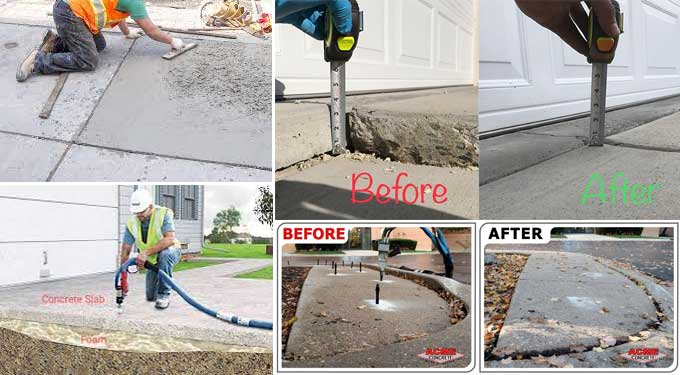
How does PolyJacking differ from MudJacking in Construction?
By using high density geo technical expanding foam, poly jacking raises and stabilizes concrete surfaces. In mud jacking, the concrete surface is raised to the desired level using mud instead of foam, which has the same objective.
Features of Poly jacking
- Poly jacking is also known as concrete lifting or poly lifting. Over the settled concrete slab, holes are drilled and high density Poly jacking foam is injected into the holes to fill the cracks and voids.
- Poly jacking foam expands to 7 feet under each drilled hole after injection. By doing this, the concrete slab can be raised and the structure is stabilized as well.
- Poly jacking foam does not degrade over time, unlike mud jacking slurry or mud.
- In addition to sidewalk and driveway resurfacing, poly jacking can also be used for repairing floors in garages and basements, warehouses, sports arenas, and warehouse floors.
- In comparison to other concrete repair methods, poly jacking requires fewer holes to be drilled.
- As compared to the mud jacking slurry, Poly jacking foam is lighter. In this way, no pressure is exerted on the soil below.
- To inject the foam material, fewer holes need to be drilled.
Benefits of Poly Jacking
It is cost effective to use poly jacking instead of replacing concrete surfaces. It is cost effective to use poly jacking.
The surface is ready for use due to the faster curing process in just a few hours As a result, the concrete surface retains its structural integrity and compressive strength.
As a result, joints and cracks are sealed, and future heaves are prevented. With 39 to 49 percent of renewable and recycled materials, Polyjacking is an environmentally friendly material. It creates a clean working environment because there is no concrete or grout splatter during the process.
Difference between Poly Jacking & Mud Jacking
Expected Time
Compared to mud jacking, Poly jacking is faster. In minutes, Poly jacking foam cures, so you can walk or drive on it immediately.
While mud jacking takes 24 to 72 hours to cure, foot traffic can be allowed on the lifted concrete. Parking lots are important to commercial owners who rely on them for business, so this is both inconvenient and detrimental.
Water Resistance & Moisture
Several polyurethanes are hydrophobic, which means they can be used underwater or in wet conditions. Moisture cannot penetrate the foam like material because it creates a moisture barrier. It can help keep your concrete level and also keep water from leaking into your building or home. It is important to note that mud jacking does not offer any water resistance to protect your concrete or structure.
Cost
In comparison to polyurethane, mud jacking costs less. The process will likely need to be repeated since there is no guarantee that the concrete will remain leveled.
Polyurethane should be applied correctly the first time. The upfront costs are higher, but the long term costs and potential cleanup and repair costs are much lower.
Appearance Look
With polyurethane, fewer and smaller holes are drilled into concrete slabs, one inch smaller to be precise. In contrast, mud jacking requires much larger and more numerous holes. As a result, poly jacking produces a finished product that is cleaner and more polished. Furthermore, fewer resources and heavy equipment are needed, so your home or business will be disrupted less, and the job site will look neater.
Weight
In many cases, settled concrete occurs because of poor soil conditions under the slab. To avoid further burdening the already weak soil, you should use a lightweight material. Polyurethane is far lighter than mud jacking, weighing only 2 to 4 pounds per cubic foot.
To get more details, watch the following video tutorial.
Video Source: The Real Seal, LLC
Longevity
Concrete is lifted by mud jacking, which relies on the soil underneath to support the loads. It is possible for the underlying soils to shift and crack your concrete due to freezing and thawing cycles or decaying tree roots. You can't guarantee that mud jacking will keep your concrete smooth and level.
It won't fail because polyurethane hardens as a result of chemical reactions with the soil. Consequently, your concrete should last a lifetime as this stabilizes the soil and concrete.


